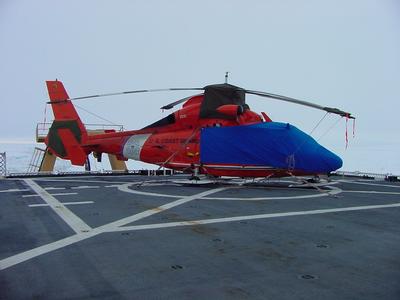31 August, 2001
August 31, 2001
Looking Ahead
Traveling in the Arctic can be tricky, so navigators use all of the help
they can get. With the great instruments on board for detecting ice and
predicting weather, travel is easier. However, the good old-fashioned human
eye can be a great instrument, too.
The 2 helicopters on board the Healy have been put to good use lately
through ice reconnaissance missions. Ice reconnaissance is where the pilots
and their crew take a trained "ice observer" and fly ahead of the ship to
look for leads in the ice. This expert understands the ice and how well the
ship moves through it in a variety of conditions.
There are certain circumstances to look for when on ice reconnaissance. Of
course the best situation is to find open water, but if that isn't
available, the next best thing would be to find large leads or channels.
If one must encounter ice, some types are better suited to travel through
than others. The general types include new ice (just forming), first year
ice (only 1 season old), and multi-year ice (survived at least 2 seasons).
The old, multi-year ice is the most unpopular to travel through as it's
generally thicker and harder than other ice.
Also important are the characteristics of the ice. How thick is it? Does
have pressure ridges? Ice under pressure is more likely to cause a ship to
become stuck, and it uses time and energy to get out. If this
characteristic can be detected through ice reconnaissance, the ship can
avoid it.
An observer may scout out an area of 50 miles or more ahead of the ship. An
instrument called a GPS (Global Positioning System) is used to help
accurately locate positioning so a drawing of the ice conditions can be made
on a chart. This chart can then be used to help ensure more efficient
travel by the ship.
Good old-fashioned human observation is a useful tool in icy waters, so it
certainly pays to look ahead!

This is a map of Gakkel Ridge. The red line shows our proposed path, and we are currently around point #6.

This helicopter is covered for protection from the elements. It has just returned >from an ice reconnaissance mission.
Contact the TEA in the field at
.
If you cannot connect through your browser, copy the
TEA's e-mail address in the "To:" line of
your favorite e-mail package.
|
